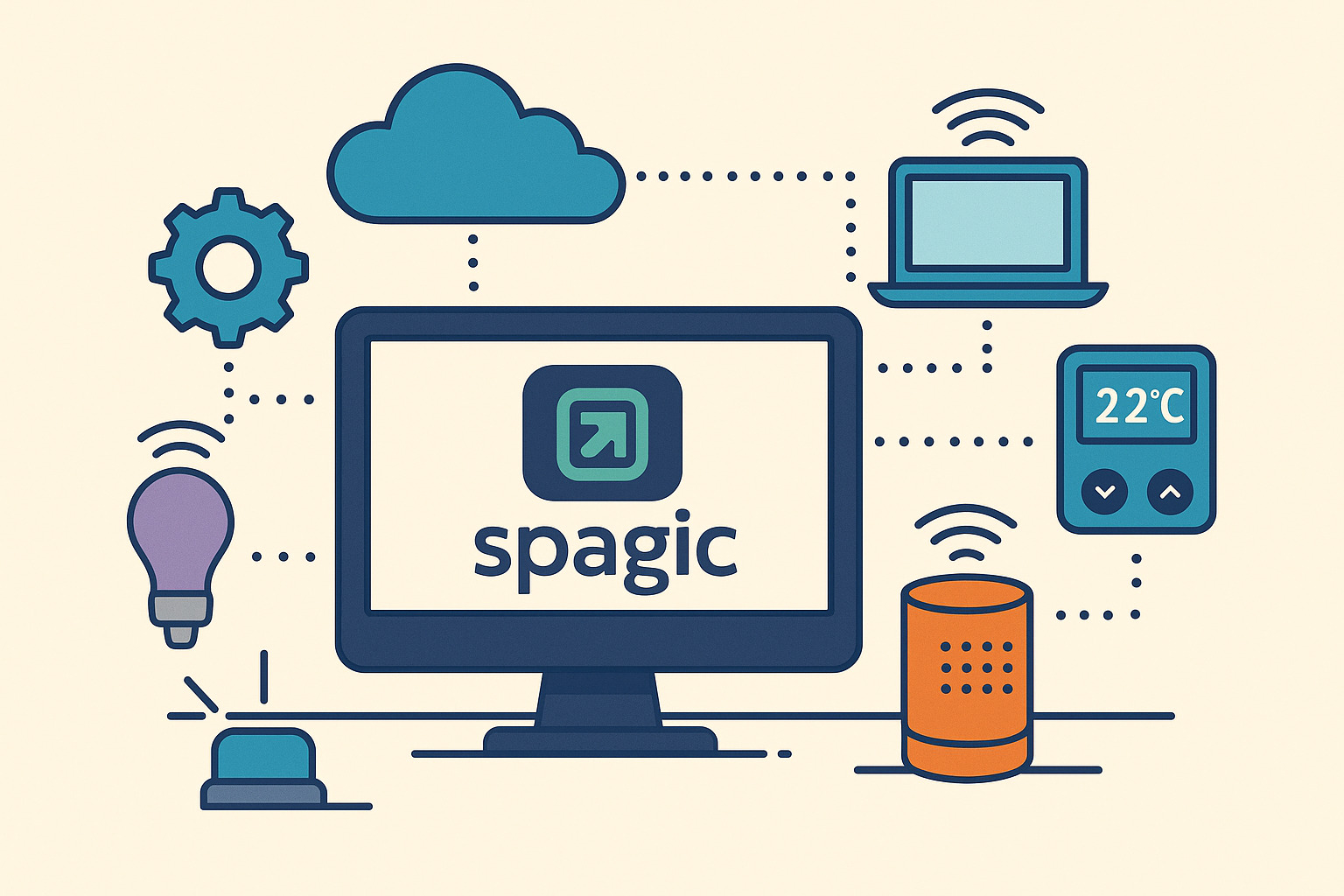
Connecting Spagic Middleware to IoT Devices for More Effective Automation
In this era of automation and interconnectivity, establishing a solid integration between enterprise systems and IoT devices is crucial. Through Spagic Middleware, centralized orchestration of previously siloed processes becomes possible. Whether you’re using sensors, smart modules, or embedded devices, this integration provides clearer control and real-time visibility. For tech teams, business developers, and integration engineers, understanding how these two technologies connect is a major advantage.
Purpose of Connecting Spagic to IoT Devices
Spagic Middleware is designed to unify various applications, services, and systems. This makes it a natural interface for IoT devices that need to be monitored and controlled within a unified workflow. Through this integration, raw data from devices can pass through logic rules, transformation steps, and orchestration flows—without needing to alter the devices themselves.
This allows for the creation of automated processes. For example, if a sensor detects a temperature change, a Spagic rule can trigger an air control system to adjust automatically. There’s no need for manual intervention, and the system continues to run according to the initial business rules.
It also streamlines data flow. Data that once required manual logging now passes through predefined workflows, is stored in databases, and becomes instantly accessible by analytics platforms. This level of automation significantly impacts decision-making and operational efficiency.
Using Spagic’s Service-Oriented Architecture
One key reason Spagic is a strong candidate for IoT integration is its use of a service-oriented architecture (SOA). Each function within the system is treated as an independent service. This allows device-generated data to flow through multiple services in a distributed but coordinated manner.
Using service orchestration, rules can be defined that trigger specific services based on IoT input. For instance, if a motion sensor detects movement at night, Spagic’s lighting service can be triggered to turn on the lights. With pre-built connectors and integration points, implementation becomes simpler.
Thanks to Spagic’s modularity, services can be added or removed as needed without reworking the entire system. This flexibility is perfect for environments where device setups and business goals frequently change.
Parsing Data from IoT Protocols
One technical challenge in IoT integration is handling the variety of protocols. Many devices use MQTT, CoAP, or HTTP-based messaging. To integrate these with Spagic, the data must be properly parsed and converted into a format compatible with middleware workflows.
Spagic’s built-in capabilities allow setting up listeners or connectors that receive messages from devices. Once data is received, it goes through a transformation step using XSLT, JSON mapping, or XML parsing to become compatible with internal service flows.
For example, a device sending JSON payloads via MQTT can be handled by a message handler in Spagic, which extracts specific fields like temperature and passes them to business logic for processing. No external parsing tool is needed—Spagic handles it all internally.
Using BPM for Orchestrating Device Events
One of Spagic’s well-known features is its use of Business Process Modeling (BPM). By visually designing process flows, it becomes easier to understand how the system responds to IoT triggers. Even without deep programming knowledge, users can model data flows and actions via the UI.
For example, a process might start with a sensor trigger event, followed by a decision gateway: if the temperature is high, it triggers the cooling system; if not, it logs the data. Each step has parameters that can be adjusted to fit different scenarios.
Using BPM also enhances system transparency. If business logic changes, there’s no need to rewrite code—just update the visual model and redeploy. This is extremely useful in fast-changing IoT setups where flexibility and maintainability are essential.
Storing Sensor Data for Analysis
Processing IoT data in real time isn’t always enough. Often, data needs to be logged for analytics, reporting, or auditing. In Spagic, workflows can be connected to relational or NoSQL databases to store device-generated data.
You can set up processes to save raw sensor readings with timestamps and device IDs. This enables historical analysis—for example, identifying when humidity spikes frequently in a warehouse.
Since Spagic supports various databases like MySQL, PostgreSQL, MongoDB, or enterprise storage, users have flexible options. Retention policies can also be configured to manage data bloat, helping teams implement a smarter data strategy.
Real-Time Alerts and Automated Responses
A critical part of IoT integration is real-time alerting. When a device reports an unusual reading, the event needs to be communicated instantly. In Spagic, alerts can be configured via email, SMS, or API calls to third-party tools.
For example, if a freezer monitoring sensor detects abnormal temperatures, Spagic can send an alert to a technician and simultaneously trigger a backup cooling system. This automation isn’t just convenient—it can save resources, reduce downtime, and improve safety.
Because the system reacts in real time, it reduces human error and response delays, making it ideal for critical environments.
The Role of API Gateways in Integration
To enable broader connectivity with IoT platforms, API gateways are often used. In Spagic, services can be exposed as REST or SOAP endpoints, allowing any HTTP-capable IoT device or gateway to interact with the middleware.
This API-based approach gives teams control over authentication, payload structures, and response formats. For example, a smart thermostat can request new configurations from Spagic’s API based on input from a central management platform.
The flexibility of API endpoints allows Spagic to connect with cloud-based IoT platforms like AWS IoT Core, Azure IoT Hub, or proprietary device management tools—without needing to modify the entire system for every new device.
System Scalability as Devices Increase
As enterprises deploy more IoT devices, systems must be capable of scaling. With Spagic, workflows and integration logic are designed to scale with the number of events or connected devices.
You can add service instances or load balance requests across threads or nodes. It also supports asynchronous processing via message queues or parallel service invocations. This ensures data won’t get stuck even when thousands of devices report simultaneously.
Such scalability is vital for production plants, smart cities, and logistics networks where devices constantly generate data. The ability to scale without downtime underpins system reliability.
Security Considerations for Integration
Connecting devices to Spagic isn’t enough—they must also communicate securely. SSL can be enforced on APIs, token-based authentication required for every request, and encryption applied to stored data.
Each device should have identity validation—random devices should not be able to send data. Whitelisting and digital signatures can verify message authenticity.
Additionally, Spagic can monitor for suspicious activity. If a source sends too many requests, it can be blocked or flagged. This helps keep the entire integration secure and free from vulnerabilities.
Strengthening the System Through Modular Integration
One of the biggest advantages of using Spagic in IoT integration is its modular design. You can add devices, replace services, or change logic without affecting the overall architecture. This is essential for systems in constant evolution.
Modularity also enables teams to work independently. A device team can send raw data while the logic team handles actions via Spagic workflows—no overlap required, speeding up development cycles.
As the system grows, it stays manageable. Each function is compartmentalized, making it easier to troubleshoot, maintain, and upgrade. Ultimately, this leads to a more organized, secure, and responsive IoT environment.

